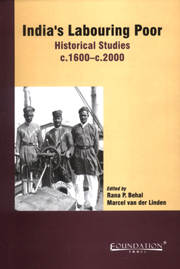Book contents
- Frontmatter
- Contents
- Notes on Contributors
- Frontispiece
- Preface
- Introduction
- Working Across the Seas: Indian Maritime Labourers in India, Britain, and in Between, 1600–1857
- The Brickmakers' Strikes on the Ganges Canal in 1848–1849
- On the Move: Circulating Labour in Pre-Colonial, Colonial, and Post-Colonial India
- Mobility and Containment: The Voyages of South Asian Seamen, c. 1900–1960
- Power Structure, Discipline and Labour in Assam Tea Plantations during Colonial Rule
- “Following Custom”? Representations of Community among Indian Immigrant Labour in the West Indies, 1880–1920
- Masculinity, Respect, and the Tragic: Themes of Proletarian Humor in Contemporary Industrial Delhi
- Stretching Labour Historiography: Pointers from South Asia
- DOCUMENT
- Editorial introduction
- War on the Shopfloor
- Select Bibliography
War on the Shopfloor
from DOCUMENT
Published online by Cambridge University Press: 05 January 2012
- Frontmatter
- Contents
- Notes on Contributors
- Frontispiece
- Preface
- Introduction
- Working Across the Seas: Indian Maritime Labourers in India, Britain, and in Between, 1600–1857
- The Brickmakers' Strikes on the Ganges Canal in 1848–1849
- On the Move: Circulating Labour in Pre-Colonial, Colonial, and Post-Colonial India
- Mobility and Containment: The Voyages of South Asian Seamen, c. 1900–1960
- Power Structure, Discipline and Labour in Assam Tea Plantations during Colonial Rule
- “Following Custom”? Representations of Community among Indian Immigrant Labour in the West Indies, 1880–1920
- Masculinity, Respect, and the Tragic: Themes of Proletarian Humor in Contemporary Industrial Delhi
- Stretching Labour Historiography: Pointers from South Asia
- DOCUMENT
- Editorial introduction
- War on the Shopfloor
- Select Bibliography
Summary
The outbreak of World War II accentuated, and its conduct and immediate aftermath sustained, the mounting pressures on the jobber system and exposed its weaknesses more fully. These pressures upon the jobber emanated from three sources. First, the imperatives of the war economy facilitated the more intensive exploitation of labour. The jobber's traditional task, to reconcile workers to the demands of the mill-owners, became almost impossible to sustain. Indeed, it drew the full wrath of the workers upon the jobber.
Second, the 1940s witnessed deepening tensions and bitter conflicts at the workplace. Attempts to enforce labour discipline under these conditions met with fierce, sometimes violent, resistance. The general strikes of 1940 and 1950, co-ordinated across the industry, revealed the perennial weakness of jobbers, when called upon to operate at a supra-mill level. Conversely, strikes occurred with greater frequency in individual mills in the mid 1940s. These were fractious disputes, often accompanied by violence directed at jobbers as well as supervisors and managers. To some extent, these disputes were fuelled by rivalries within the managerial hierarchy, as various ranks of managers intervened in the jobber's domain and as power balances shifted within the supervisory apparatus of the mills.
Third, the decade was marked by political volatility. Apart from the increasing number of strikes between 1943 and 1947, the Quit India movement, launched from Bombay, proved the most powerful of the Gandhian agitations and the most ruthlessly suppressed. In 1941 and 1944, the city was wracked by communal riots. When they recurred in 1946–1947, they raged with an unprecedented ferocity.
- Type
- Chapter
- Information
- India's Labouring PoorHistorical Studies, 1600-2000, pp. 265 - 278Publisher: Foundation BooksPrint publication year: 2007



